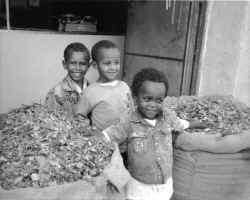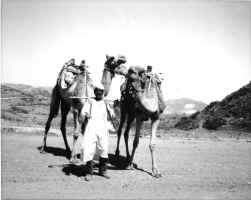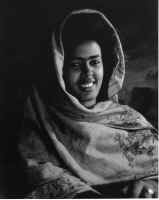|
Africa's
Eritrea Revels in First Tastes of Peace and Freedom
Byline:
Christina Henning/For The News Tribune
Published
8/15/93
"Cappuccino with cognac?" the Eritrean waiter
asked. This question will be a shock to your system if
you've come, as I did, from neighboring Sudan, where drinking alcohol can get you as much as 40 lashes.
Only 25 minutes away from
Sudan
and the Sharia (Islamic Law), you can experience the full
excitement of Africa, yet have all the comforts and
flavors of Europe. Compared to the disorganized atmosphere
of
Sudan, Eritrea
will give you back a sense of familiarity. It's a country
where nothing requires a bribe, and prices are fixed for
everyone, even the foreigners.
Eritrea
is located in the Horn of
Africa on the west coast of the Red Sea and is roughly the
size of
Mississippi, with a coastline of 1,000 kilometers. It borders
Sudan
to the north,
Ethiopia
to the south and Djibouti
at the extreme southeast tip. The name Eritrea
was given by the Italians and comes from the Greek word
for "red." It is also a new member of the
community of nations. In April, following a United
Nations-monitored referendum,
Eritrea
's voters overwhelmingly declared their desire to become a
sovereign nation, free from Ethiopia.
The
country was under complete Italian control from 1890 to
1941. This explains why
Asmara, the capital of
Eritrea
, is called Little Rome and reflects the flavor of the
Italian Renaissance. It is perched on a plateau 2,300
meters above sea level and experiences a cool and healthy
climate year-round. The sidewalks are tiled and lined with
well-manicured palm trees, open piazzas and outdoor cafes
where you can sip cappuccino with cognac, eat pastry and
brush up on your Italian with old Ethiopian and Italian
men. The bars are open until the wee hours and offer
Saturday night dancing.
The general street life has a carnival-like atmosphere
that increases in tempo as the evening progresses. Germa
Asmorom, executive producer at the only TV station in
Asmara, said this about the city's excitement before the vote:
"Just wait until after the referendum this year; it
will be like Rio De Janeiro." The celebration continues.
However, not everyone shares Asmorom's enthusiasm for the
carefree behavior of the Eritreans. "I would not
bring my family into this kind of environment. They drink
all day . . . to forget the past," said Abduhla
Ibrihim, a Sudanese embassy official in Asmara. "Forget what? Forget 600 years?" Asmarom
snapped. "This is part of our heritage!"
Remarkably,
Asmara
was untouched by Eritrea's 30-year war (it ended in 1991) and has the look and
feel of an oasis, surrounded by the sands of conflict.
The reason for the celebrations has to do with the
homecoming of a large number of Eritreans who have been
refugees in
Sudan, the Middle East, Europe and America
for up to 30 years. These are the people who gave
financial support to the revolution and the families left
behind.
My hotel,
the Lul Leghesse in central Asmara, is filled with Americanized Eritreans, speaking broken
English with a variety of regional American accents. Their
teenage children parade through the hotel lobby displaying
the trendiest American fashions, while the parents are
overwhelmed by meeting family members and childhood
friends they haven't seen in years.
Neghisti
Seqoar, an office worker from
San Francisco
, has come back to Eritrea
after 15 years in exile to take part in the referendum. We
meet in the hotel bar for a cappuccino. Neghisti walks
over and greets me, pushing her right shoulder into mine
and then repeating the same movement with her left
shoulder. It's the Eritrean national greeting. "I am
so happy that we have our country back! I feel so
invigorated! I
gave up my job and put everything in storage. I may be
here for three to seven months, but who knows?" she
said. "Most likely I will go back to America. The Americans have been good to me."
Asmara
is host to visitors from many other Arab countries. The
wealthy Sudanese choose Asmara
for their honeymoons. The Persian Gulf Arabs escape to Asmara
for the nightlife and freedom that's unavailable to them
in their Islamic homeland.
 But outside this sophisticated metropolitan hub is still
the old
Africa, untouched by the modern world. A few kilometers past the
modern walls of Asmara
are typical Eritrean villages, with scattered round huts
made out of straw and mud. Nearby, Christian and Muslim
villagers work the fields together with age-old tools
planting wheat, lentils, linseed, peas and beans. The
nomadic caravaners on camels, called "ships of the
desert," move silently past the villages. But outside this sophisticated metropolitan hub is still
the old
Africa, untouched by the modern world. A few kilometers past the
modern walls of Asmara
are typical Eritrean villages, with scattered round huts
made out of straw and mud. Nearby, Christian and Muslim
villagers work the fields together with age-old tools
planting wheat, lentils, linseed, peas and beans. The
nomadic caravaners on camels, called "ships of the
desert," move silently past the villages.
Eritrea
is made up of nine major ethnic groups: Afar, Bilen,
Hadareb Kunama,
Nara
, Reshaida, Saho, Tigre,
and Tigrinya, each with its own traditional culture and
language.
Religion
is divided equally between the nomadic Muslims in the
lowlands and the Orthodox Christians who split from
mainstream Christianity in the sixth century A.D. and are
related to Coptic Christianity. A small percentage are
animists, believing in the existence of spirits and
demons.
The Afar
tribe enjoy an interesting reputation for collecting human
testicles as trophies. They are traders who wander freely
with their camels between
Eritrea
and Djibouti. Yet these different groups with a wide variety of
backgrounds have struggled together as Eritreans against a
series of colonial oppressors: the Italians, the British,
and the Ethiopians.
Two hours
from the festivities of
Asmara
is Massawa, the main port of entry on the
Red Sea
coast. In its last year of war, Massawa became the most
savage battlefield, as Soviet-made Ethiopian
fighter-bombers dropped napalm and cluster bombs on
civilians. Massawa was captured by
Eritrea, and the ghostly shells of houses and churches stand as a
memory and symbol of Eritrea's liberation. And for foreign visitors, Massawa is a
window that will give them a glimpse of the war and the
suffering it has produced.
The
Eritreans are celebrating the end of the longest ongoing
war in modern history. They are celebrating Eritrean
independence and the homecoming of their displaced family
members. How long the celebration will last, or what
happens after that, is anyone's guess. Now is an opportune
time to visit Eritrea
and join the swirling carnival of laughter and merriment.
As I
approach the
Asmara
airport for my flight back to Khartoum,
Sudan, I have the urge for one more cappuccino with cognac.
Worse yet, I want to go back to my hotel and fill my water
bottle with it. But visions of 40 lashes in the public
market, plus the threat of having my passport marked as an
undesirable, stopped me. With the best intentions, I faced
customs at the Khartoum
airport. The customs official dressed in her Islamic hijab
(long, loose, flowing clothing, with the head and hands
covered) jolted me back to reality. "Are you carrying
any beer, wine or cognac?" she growled at me.
"Of course not," I snapped back at her. "I
don't drink!"
If you go ...
*Visas are required of American citizens visiting Eritrea. Call the Department of State in Washington,
D.C.
, at 202-647-5225 for up-to-date travel information. The
Embassy of Eritrea in
Khartoum
is located in Khartoum
2, near the UNISEF office, and grants visas in 24 hours.
You need to bring a letter of introduction from the
American Embassy (phone 74611 or 74700), 200 Sudanese
pounds, and two passport photos.
*Several airlines - Sudan Airways, Ethiopian Airlines,
and Lufthansa - fly into Eritrea
from
Cairo, the hub for all travel in the
Middle East. The best deal as far as money goes is Sudan Airways. Be
forewarned that it is referred to as Insha'alla Airways.
It means the plane leaves when Allah wishes it. Delays of
many hours are not unusual.
*The Eritrean Tour service is located on Liberty Avenue
No. 61, in Asmara
(phone 11-99-99), and will arrange tours, accommodations,
and car rentals.
*Some of the world's natural wonders are close to
Eritrea, including the Danakil Alps and Africa's
Great Rift Valley. And for the adventurous, there is a bus that leaves from
Asmara
for Kassala at the Sudanese border. The trip takes three
days and two nights through mountains and desert roads
that are unpaved.
c.
2006, Christina Henning
|
|

